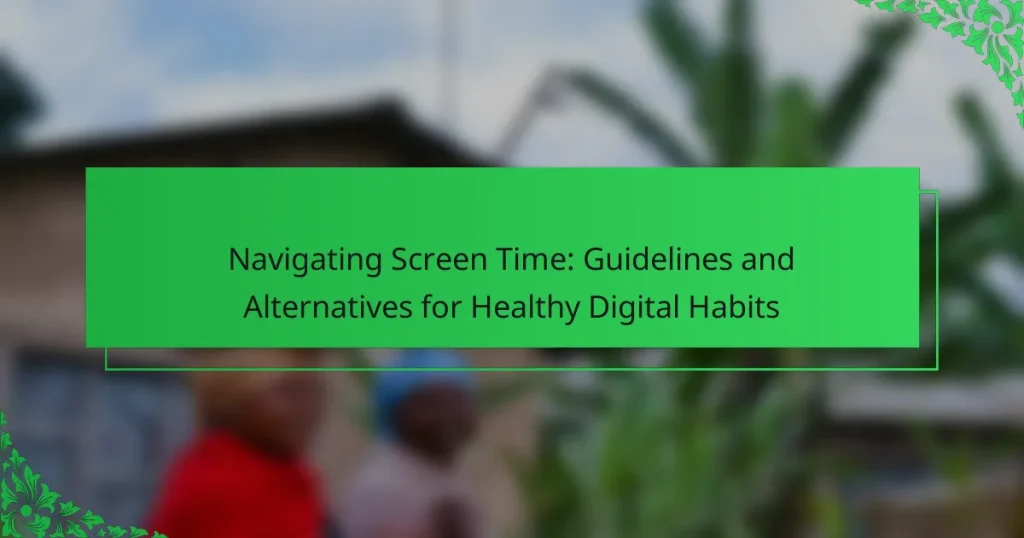
What are the current guidelines for screen time management?
The current guidelines for screen time management recommend specific limits based on age. For children aged 2 to 5 years, screen time should be limited to one hour of high-quality programming per day. For children younger than 18 months, screen time is discouraged, except for video chatting. Parents and caregivers should co-view media to help children understand content. For older children and teens, consistent limits on screen time are advised to ensure a balance with physical activity and sleep. The American Academy of Pediatrics emphasizes the importance of setting boundaries and encouraging healthy media habits. These guidelines aim to promote healthy development and well-being in children.
How do these guidelines vary by age group?
Screen time guidelines vary significantly by age group. For children aged 2 to 5, experts recommend no more than one hour of high-quality programming daily. This limit helps ensure that young children engage in other essential activities such as play and social interaction. For children aged 6 to 18, the American Academy of Pediatrics suggests consistent limits on screen time to promote healthy habits. They emphasize the importance of balancing screen time with physical activity and sleep. Adolescents may require more flexibility, but guidelines still advocate for monitoring content and encouraging face-to-face interactions. Research shows that excessive screen time can lead to negative health outcomes, including obesity and sleep disturbances. Therefore, age-appropriate guidelines are crucial for fostering healthy digital habits.
What recommendations exist for children regarding screen time?
The American Academy of Pediatrics recommends limiting screen time for children aged 2 to 5 years to one hour of high-quality programming per day. For children younger than 18 months, they suggest avoiding screen time, except for video chatting. Parents should co-view media with children to enhance understanding and encourage discussions. For older children, consistent limits on screen time should be established, ensuring it does not interfere with sleep, physical activity, and other healthy behaviors. Research shows that excessive screen time can lead to negative outcomes such as obesity and sleep issues. The guidelines emphasize the importance of balancing screen time with other activities.
What are the suggested screen time limits for teenagers?
Teenagers are suggested to have a screen time limit of no more than two hours per day. This recommendation is based on guidelines from the American Academy of Pediatrics. Excessive screen time can lead to negative health effects such as sleep disturbances and decreased physical activity. Balancing screen time with other activities is crucial for overall well-being. Engaging in physical activities and face-to-face interactions should be prioritized alongside digital engagement.
Why is it important to follow screen time guidelines?
Following screen time guidelines is important to promote healthy development in children and adolescents. Excessive screen time can lead to negative health outcomes. These include sleep disturbances, obesity, and impaired social skills. Research indicates that children who exceed recommended screen time limits may struggle with attention and learning. The American Academy of Pediatrics recommends specific limits based on age. For example, children aged 2 to 5 should have no more than one hour of high-quality programming per day. Following these guidelines can enhance physical activity and social interactions. Ultimately, adhering to screen time recommendations supports overall well-being and cognitive development.
What are the potential health risks associated with excessive screen time?
Excessive screen time can lead to various health risks. These include eye strain, commonly referred to as computer vision syndrome. Symptoms may involve headaches, blurred vision, and dry eyes. Prolonged screen exposure can also contribute to poor posture, resulting in musculoskeletal issues. Additionally, excessive screen time is linked to sleep disturbances, as blue light affects melatonin production. Mental health concerns such as anxiety and depression may arise due to increased screen time, especially on social media platforms. According to the American Academy of Pediatrics, children and adolescents are particularly vulnerable to these effects. Reducing screen time can mitigate these health risks significantly.
How can following guidelines improve overall well-being?
Following guidelines can improve overall well-being by promoting healthier screen time habits. These guidelines encourage balanced usage of digital devices. They help reduce eye strain and fatigue associated with prolonged screen exposure. Research indicates that limiting screen time can enhance mental health by decreasing anxiety and depression levels. For example, a study published in the journal “JAMA Psychiatry” found a correlation between excessive screen time and increased symptoms of depression in adolescents. Additionally, guidelines often recommend regular breaks, which can improve focus and productivity. By fostering real-life social interactions, these guidelines can enhance emotional well-being. Overall, adhering to these recommendations supports a healthier lifestyle.

What alternatives to screen time can promote healthy habits?
Engaging in physical activities is a key alternative to screen time that promotes healthy habits. Activities like walking, cycling, or playing sports enhance physical fitness. They also improve mental well-being by reducing stress and anxiety. Reading books is another beneficial alternative. It stimulates the mind and enhances vocabulary. Creative hobbies, such as drawing or crafting, foster creativity and relaxation. Spending time outdoors in nature promotes physical health and mental clarity. Social interactions through face-to-face conversations strengthen relationships and emotional health. Mindfulness practices, such as yoga or meditation, improve focus and reduce stress levels. Each of these alternatives supports overall health and well-being.
What activities can replace screen time for children?
Engaging in outdoor play can effectively replace screen time for children. Activities such as biking, hiking, and playing sports promote physical health. Creative pursuits like drawing, painting, or crafting stimulate imagination and fine motor skills. Reading books enhances literacy and cognitive development. Playing board games fosters social skills and critical thinking. Cooking or baking together teaches practical life skills and encourages teamwork. Gardening connects children with nature and teaches responsibility. These activities provide diverse benefits that support children’s overall well-being.
How can outdoor play benefit children’s development?
Outdoor play significantly benefits children’s development by promoting physical health, social skills, and cognitive growth. Engaging in outdoor activities enhances children’s motor skills and overall fitness. Research indicates that children who play outside are more active, reducing the risk of obesity. Outdoor play fosters social interactions, helping children develop teamwork and communication skills. It also encourages creativity and problem-solving as children navigate their environment. Studies show that exposure to natural settings can improve attention spans and reduce symptoms of ADHD. Overall, outdoor play is essential for holistic child development.
What role does reading play in reducing screen time?
Reading significantly reduces screen time by providing an engaging alternative to digital devices. It encourages individuals to immerse themselves in stories or information without relying on screens. Research indicates that adults who read regularly spend less time on screens compared to those who do not. A study published in the journal “Pediatrics” found that children who engage in reading are less likely to exceed recommended screen time limits. This shift to reading fosters better focus and cognitive engagement, further decreasing the urge to use screens. Additionally, reading can serve as a calming activity, reducing the likelihood of turning to screens for relaxation or entertainment.
How can adults find balance in their screen time use?
Adults can find balance in their screen time use by setting clear boundaries. Establish specific time limits for recreational screen use. Prioritize activities that do not involve screens, such as reading or exercising. Schedule regular breaks during prolonged screen use to reduce eye strain. Engage in face-to-face interactions to maintain social connections. Use apps to track and manage screen time effectively. Research indicates that excessive screen time can lead to negative health outcomes, including sleep disturbances and anxiety. Balancing screen time promotes overall well-being and productivity.
What strategies can adults implement to limit screen time effectively?
Adults can implement several strategies to limit screen time effectively. Setting specific time limits for daily screen use is essential. Adults should designate tech-free zones in their homes. Engaging in alternative activities, like reading or exercising, can reduce screen reliance. Scheduling screen-free times during meals or before bedtime promotes healthier habits. Tracking screen time through apps can increase awareness of usage patterns. Prioritizing face-to-face interactions over digital communication enhances social connections. Research indicates that reducing screen time can improve mental well-being and sleep quality.
How can mindfulness practices support healthier digital habits?
Mindfulness practices can support healthier digital habits by promoting awareness of screen time usage. They encourage individuals to recognize their emotional responses to digital interactions. This awareness can lead to more intentional decisions about when and how to engage with technology. Mindfulness techniques, such as meditation and deep breathing, can reduce impulsive behaviors associated with excessive screen time. Research indicates that mindfulness can decrease anxiety and improve focus, which helps individuals resist distractions from digital devices. A study by Zeidan et al. (2010) found that mindfulness training enhances attention and cognitive flexibility. These benefits contribute to a more balanced relationship with technology, fostering healthier habits overall.

What are the best practices for managing screen time effectively?
Establishing clear boundaries for screen time is essential for effective management. Set specific time limits for daily usage. This helps reduce excessive screen exposure. Encourage breaks every hour to minimize eye strain. Engaging in physical activities during these breaks promotes overall health. Designate screen-free zones, such as bedrooms and dining areas. This fosters healthier habits and family interactions. Use apps to monitor and limit screen time effectively. Studies indicate that structured screen time leads to better focus and productivity.
How can families create a balanced digital environment?
Families can create a balanced digital environment by setting clear screen time limits. Establish specific times for device use, such as during homework or family meals. Encourage offline activities like reading, sports, or arts and crafts to promote engagement without screens. Designate tech-free zones in the home, such as bedrooms and dining areas, to foster family interaction. Use parental controls to monitor and limit content accessible to children. Educate family members about online safety and the importance of digital etiquette. Regularly discuss digital experiences and feelings to ensure open communication. Research indicates that families who actively manage screen time report higher satisfaction and better relationships.
What tools and apps are available to monitor screen time?
Several tools and apps are available to monitor screen time. Popular options include Apple’s Screen Time, which tracks device usage across iOS devices. Google Digital Wellbeing offers similar features for Android users, allowing them to see app usage statistics. Microsoft Family Safety provides screen time management for family accounts on Windows devices. Apps like RescueTime and Moment offer detailed insights into daily screen habits. These tools help users understand their screen time and promote healthier digital habits.
How can setting screen-free zones enhance family interactions?
Setting screen-free zones enhances family interactions by creating uninterrupted time for communication and bonding. These zones encourage face-to-face conversations, which can strengthen relationships. Research shows that families who engage in screen-free activities report higher satisfaction in their interactions. For example, a study published in the journal “Pediatrics” highlights that family meals without screens lead to improved family dynamics. Additionally, screen-free zones promote shared activities, such as games or reading, which foster collaboration and teamwork among family members. Overall, these practices help families connect more deeply and meaningfully.
What tips can individuals use to maintain healthy digital habits?
Individuals can maintain healthy digital habits by setting clear boundaries for screen time. Establish specific times for device use and stick to them. Use apps to monitor and limit screen time effectively. Prioritize face-to-face interactions over digital communication. Engage in regular physical activities to balance screen time with movement. Designate tech-free zones in the home, such as the bedroom or dining area. Practice mindfulness by being aware of your digital consumption and its effects. Take regular breaks from screens to reduce eye strain and mental fatigue. Studies show that managing screen time can improve mental well-being and productivity.
How can setting specific goals improve screen time management?
Setting specific goals can significantly enhance screen time management. Specific goals provide clear targets for users to aim for. For instance, a goal might be limiting screen time to two hours per day. This clarity helps individuals become more mindful of their usage. Research shows that individuals who set measurable goals are more likely to achieve them. A study published in the Journal of Behavioral Medicine found that goal-setting improves self-regulation. This is particularly relevant when managing digital habits. By tracking progress towards their goals, users can adjust their behaviors accordingly. Overall, specific goals create a structured approach to healthier screen time practices.
What are some common challenges in reducing screen time, and how can they be overcome?
Common challenges in reducing screen time include habit formation, social pressures, and lack of alternative activities. Habit formation makes it difficult to change established routines. Social pressures arise from peers and family who may not prioritize screen time reduction. Lack of alternative activities can lead to boredom, making screens more appealing.
To overcome these challenges, individuals can set specific goals for screen time reduction. Creating a schedule that allocates time for non-screen activities can help. Engaging in hobbies or physical activities can provide fulfilling alternatives. Additionally, seeking support from friends or family can reinforce commitment to reducing screen time. Implementing app usage trackers can provide awareness of screen time habits.
Navigating Screen Time focuses on guidelines and alternatives for promoting healthy digital habits among children and adolescents. The article outlines age-specific recommendations from the American Academy of Pediatrics, emphasizing limits on screen time to support physical activity, sleep, and overall well-being. It discusses the potential health risks associated with excessive screen use, such as obesity and sleep disturbances, while also providing strategies for families to create balanced digital environments. Additionally, the article highlights various activities that can replace screen time, including outdoor play and reading, to enhance children’s development and mental health.




